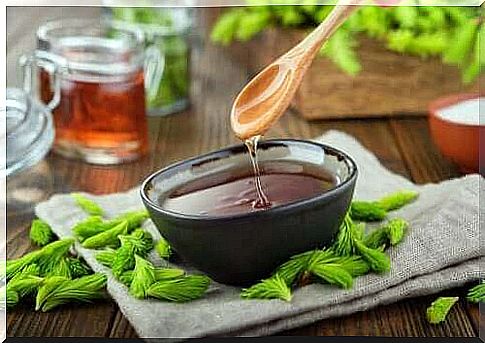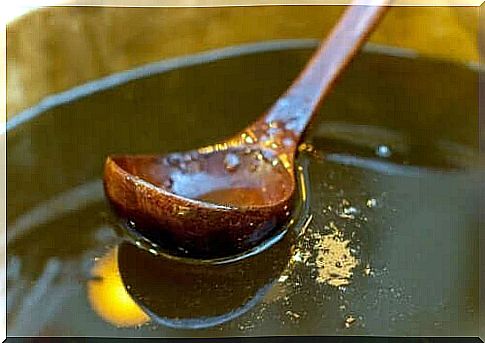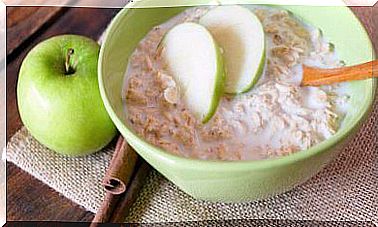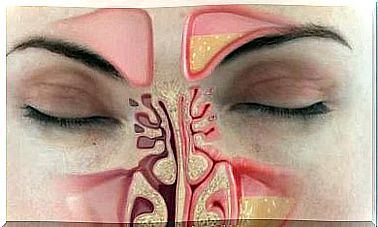Description And Properties Of Buckwheat Honey

Few people know that there are more than 300 types of honey and they have probably never even heard of buckwheat honey. It is dark in color and the taste and aroma resemble molasses.
This natural substance is made by bees from the pollen they collect from plants. It has been a treasure for centuries. The Greeks, Egyptians, Maya and Babylonians were already aware of its nourishing properties and used it for medicinal purposes.
It has a high content of antioxidants, vitamins and minerals. We also know that honey promotes wound healing, soothes coughs and helps fight infections. Below we tell you more about the properties of buckwheat honey and how you can use it in your daily life.
What is buckwheat?
This name often confuses people. It is not related to the common wheat and it is not a grain. Buckwheat ( Fagopyrum esculentum ) is the grain of a plant in the Polygonaceae family. The fruits have a triangular shape and a dark color.
Buckwheat cultivation is widespread across much of the world, but is highly concentrated in Europe, Russia, the United States, and Asia. One of the strengths of buckwheat is that it does not contain gluten and you can use it like a grain.
There are many typical dishes made with this ingredient in some countries, such as:
- Japanese soba noodles
- Galettes Bretonnes (salty crepes typical of Brittany)
- blinis in Eastern Europe
- kasha in Russia

Characteristics of Buckwheat Honey
Buckwheat honey has different characteristics than the other, more famous varieties such as flower honey, rosemary honey or eucalyptus honey.
The color may vary slightly depending on the time and location of the buckwheat pollen collection. The shades range from copper yellow to black, but the most common color is a reddish amber.
The sweet taste is of course predominant, although it is not as sweet as most honeys. It also has a bitter aftertaste, which makes it a bit itchy in the mouth. This kind of aromatic honey can remind you of beer, bread, or sugar cane.
In general, its consistency is viscous and not very runny and tends to crystallize quickly. It is a bit thick, similar to softened butter.
Benefits and Uses of Buckwheat Honey
Carbohydrates are the main ingredient of this honey, but it also contains:
- vitamins
- minerals
- organic acids
- flavonoids
- polyphenols
- volatile components
What are the main benefits? Well, let’s take a closer look at those.
It is an adjuvant in the treatment of scars and burns
The use of honey as a topical remedy for wounds is well known. You should not put it on open wounds, but it is useful for sores and scrapes. Humans benefit because it helps to stop the growth of bacteria on the surface of the skin.
Antioxidant Activity
This is due to its phenol content. Currently, studies show an increase in antioxidant compounds in the blood, but the exact role they play in the human body is still unknown.
Regardless, we do know that antioxidants play a key role in preventing premature aging and associated diseases.
Protection of the gut microbiota
The results of research presented in the journal Evidence-Based Complement Alternative Medicine indicate that buckwheat honey may provide benefits to the human gut. In particular, it nourishes the positive bifidobacteria that populate the colon. In addition, it limits the growth of those pathogens.
Recent scientific evidence points to the importance of the gut microbiota for health. A good condition improves brain function, the immune system and your nutritional status.
Antimicrobial and Antiviral Capacity
Honey can have a positive effect against common pathogens in hospital settings due to its high sugar content. Scientists have analyzed the specific activity against the following microorganisms:
- clostridium difficile
- staphylococcus aureus
- two species of Pseudomonas aeruginosa
- enterococcus faecalis
- klebsiella pneumoniae
These scientists focused their research on Wisconsin honey, and their conclusion is that you can use it along with other therapeutic agents against resistant pathogens. However, there is not enough evidence to support this claim.

Improvement of the common cold
Buckwheat honey, like regular honey, has been shown to be an adjunct in the treatment of cold symptoms. It helps to soothe coughing and improve sleep quality, especially in children.
Culinary Recommendations
One of the most common and widespread ways to use honey is by adding it to herbal teas or warm infusions. All you have to do is dilute it in a hot drink.
However, do not exceed the recommended dose of one teaspoon per cup for adults and half a teaspoon for young children. It is also very important to know that its use is not suitable for children under one year of age, due to the possibility of botulism.
It is usually a good sweetener that can easily replace regular sugar. Add a teaspoon to dishes or desserts such as:
- oatmeal
- yogurt
- cottage cheese and nuts
- orange and cinnamon
Honey’s ability to attract water is great for cakes, sandwiches and pastries. It makes them moister and thus more special and more pleasant to the taste.
You can also make a spongier bread by mixing it into a yeast dough. It’s also a great breakfast or snack spread on toast.
Use it in savory recipes that can benefit from a touch of sweetness, such as:
- vinaigrettes with mustard, red wine vinegar, or mayonnaise
- marinades for fish, meat or tofu
- caramelized nuts and seeds
Buckwheat honey, a healthy option
Buckwheat honey has a different color, texture and taste than other honeys. Still, it is a nutritious product that you can easily include in your diet in moderate amounts. It is delicious in both sweet and savory dishes, as well as in herbal teas, teas, or plain water.
Externally, it can be applied to wounds and superficial burns, as it aids in the healing process and prevents infections. Simply apply a thin layer to the desired area and cover with a clean bandage. Are you ready to try it?









